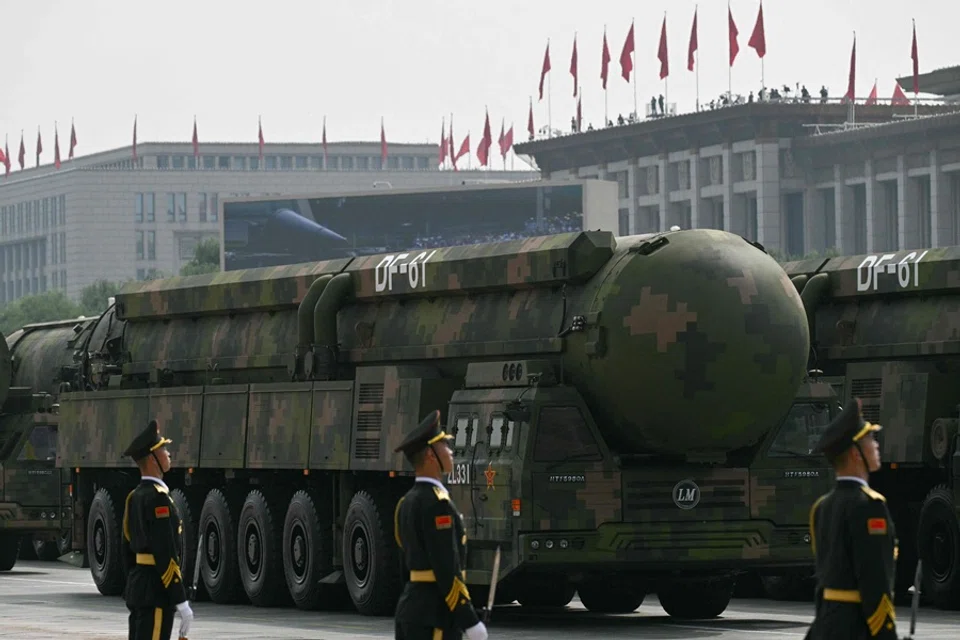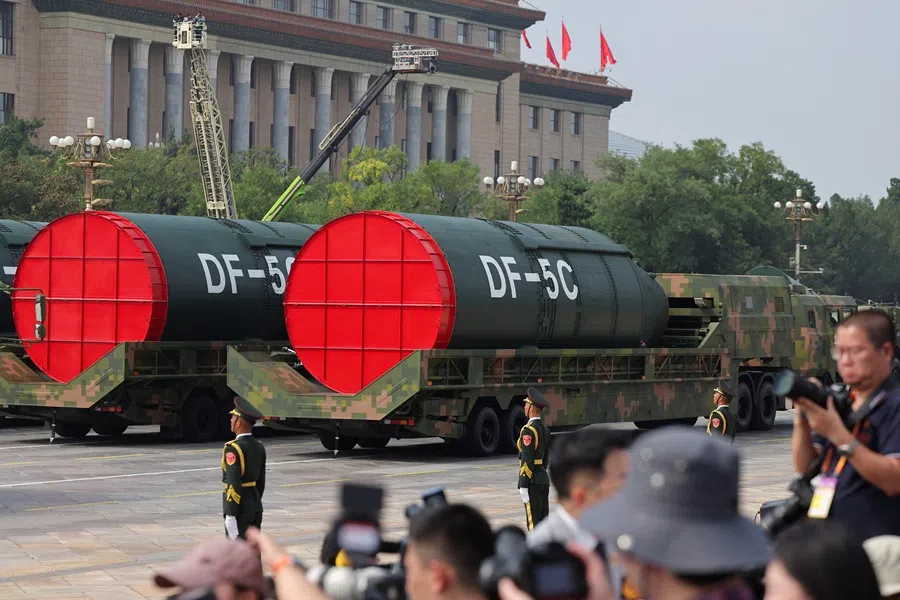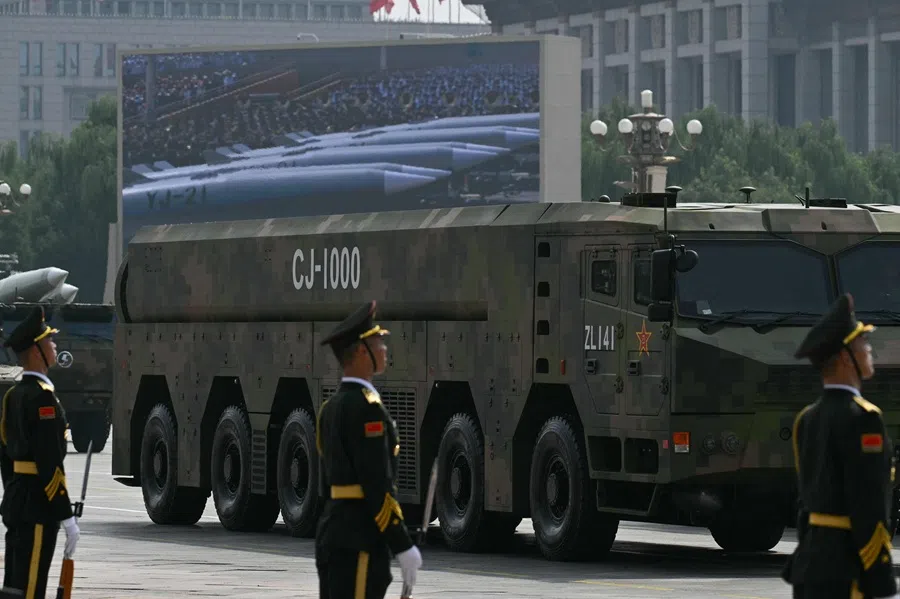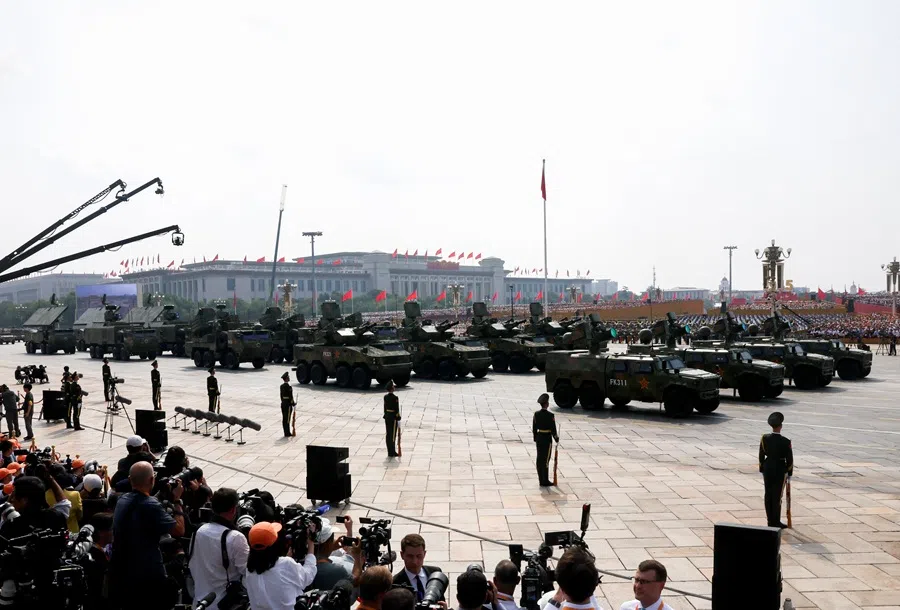China’s military is growing faster than the West can handle
China’s recent Victory Day parade showcased advanced weaponry and equipment, surprising Western commentators and leading to claims that the People’s Liberation Army is now innovating and leading in military technology. This could irrevocably change the regional military balance, observes Lianhe Zaobao correspondent Yu Zeyuan.

During the military parade on 3 September, China showcased weaponry and equipment that stunned not only military enthusiasts, but also Western commentators. An article in the US magazine Foreign Policy, titled “China’s Military is Now Leading”, stated that it is no longer enough to say that China’s military, the People’s Liberation Army (PLA), is catching up or that it is copying foreign military equipment designs, as it is now innovating and leading.
It added that in the process, the regional military balance that has for decades favoured the US and its partners is being irrevocably changed.
Display of conventional and strategic weapons
To claim that the Chinese military has comprehensively surpassed the world’s top military power, the US, might be an overstatement. However, the new weapons unveiled during the parade do indicate that some of the PLA’s equipment is leading the pack globally.
For the West, the progress of China’s strategic weapons is what draws the most attention. The Guardian reported that China showed off air-, sea- and land-launched nuclear weapons in its parade, intended to demonstrate that Beijing’s long-term aspiration is to match US military might. This includes the Dongfeng-5C (DF-5C) intercontinental missile with a range of 20,000 kilometres, and the new road-mobile DF-61 intercontinental missile.
Advancing in tandem is China’s new generation of strategic nuclear submarines equipped with the Julang-3 submarine-launched intercontinental missile, capable of reaching 6,200 miles or more. China also unveiled its first air-launched nuclear weapon, the Jinglei-1 long-range air-based missile, thus completing the deployment of a triad nuclear deterrence system.
However, strategic nuclear weapons are ultimately doomsday devices that major powers would not easily deploy unless absolutely necessary. The Russia-Ukraine war has been ongoing for over three years, with both sides suffering huge losses, yet Russia has not dared to use its tactical nuclear weapons, let alone strategic ones.
For China’s potential adversaries, the advanced conventional weapons displayed during the parade are no less intimidating than strategic weapons such as the DF-61 and DF-5C.

Hence, for localised conflicts, the advancement of conventional weapons and their production and support capabilities are crucial elements in determining victory. For China’s potential adversaries, the advanced conventional weapons displayed during the parade are no less intimidating than strategic weapons such as the DF-61 and DF-5C.
Shrinking operational space of US nuclear subs
US media noted that the parade’s drone formation included four new models that had never been publicly revealed before, including two unmanned combat aerial vehicles (UCAVs) and two collaborative combat aircraft (CCA). The War Zone website reported that they feature stealthy tailless aerodynamic designs, roughly the size of J-10 fighter jets, and possess all the characteristics of high-performance fighter jets. This suggests that these are true uncrewed stealth fighters, “a kind that the US Air Force is notably not developing.”
Its [China’s] hypersonic capabilities make it almost impossible to intercept, posing a significant threat to the second island chain and Guam.
The report noted that these two highly stealthy uncrewed air superiority combat aircraft are akin to fighter-like UCAV, capable of operating independently. In contrast, the US’s CCAs focus more on collaborative combat. Besides traditional drone tasks such as strike and intelligence, surveillance and reconnaissance, the Chinese drones could also be intended for missions similar to those of traditional fighters, including direct air combat with other platforms — this would change the future mode of air combat.
China has long excelled in missile development, and the newly unveiled CJ-1000 hypersonic cruise missile is an upgraded version of the CJ-100. According to Chinese military analysts, it boasts at least three major improvements: an extended strike range of up to 5,000 kilometres, a flight speed exceeding Mach 5, and a shift from angled to vertical launch. Its hypersonic capabilities make it almost impossible to intercept, posing a significant threat to the second island chain and Guam.

The DF-26D, often dubbed the “carrier killer”, is an upgraded version of the DF-26 missile. It features a new modular warhead, indicating a significant boost in both range and manoeuvrability. As a dual-capable intermediate-range missile, the DF-26D can strike targets both within and beyond the second island chain, as well as launch precision strikes against large, moving sea targets, making it a new nemesis for aircraft carriers.
The HSU100 unmanned underwater vehicle is an upgraded version of the HSU001, which debuted in the previous military parade. It features a more advanced cruciform rudder and pump-jet propulsion, along with an electro-optical mast on the rear upper section for communications, as well as autonomous strike capabilities.
Military analysts believe this vehicle will greatly enhance the PLA’s ability to detect nuclear submarines. While China’s development of carrier-killer missiles such as the DF-21D and DF-26 has significantly reduced the threat posed by US aircraft carriers, American nuclear submarines remain a major concern. The deployment of underwater platforms such as the HSU100 will effectively shrink the operational space of US nuclear submarines near China’s coastal waters.
New ‘iron triangle’ of drone defence
The Type 100 tank and the Type 100 support vehicle unveiled at the parade feature three breakthrough technologies: a helmet-mounted display, a 360-degree active protection system, and a hybrid modular engine. Rather than focusing on traditional tank-on-tank engagements, these platforms are designed for integrated, network-centric warfare.
With drone-based reconnaissance and target detection, they can call in long-range firepower or loitering munitions for beyond-visual-range strikes — ushering in a new model of tank warfare based on integrated reconnaissance-strike capability and non-contact engagement.
... high-power microwave weapons respond rapidly, do not require precise targeting, and can cover multiple targets simultaneously, making them well-suited for countering drone swarm attacks.

In response to the serious threat posed by drones to various transport and combat platforms on the Russia-Ukraine battlefield, the parade unveiled an anti-drone unit. Based on a modular, open-architecture design, the unit integrates a range of modern combat technologies — including missiles, artillery, lasers, optics and microwave systems — forming a multidimensional, all-encompassing and intelligent anti-drone system known as the new “iron triangle” of drone defence.
Among these, laser weapons offer key advantages such as high speed, high accuracy, unlimited ammunition, and low operating cost. Their high-energy beams can instantly destroy drones several kilometres away. Meanwhile, high-power microwave weapons respond rapidly, do not require precise targeting, and can cover multiple targets simultaneously, making them well-suited for countering drone swarm attacks.
While expressing surprise at the advanced equipment showcased in the parade, Western commentators have also questioned whether these systems are truly in service or operationally effective. They remain sceptical of the actual combat capabilities of the Chinese military, given its lack of recent battlefield experience.
Nonetheless, the rapid growth of the PLA’s strength is undeniable. Otherwise, the US and its allies would not be so concerned about the shifting political and military landscape in the Asia-Pacific and beyond.
This article was first published in Lianhe Zaobao as “解放军部分装备已全球领先”.





![[Big read] China’s 10 trillion RMB debt clean-up falls short](https://cassette.sphdigital.com.sg/image/thinkchina/d08cfc72b13782693c25f2fcbf886fa7673723efca260881e7086211b082e66c)